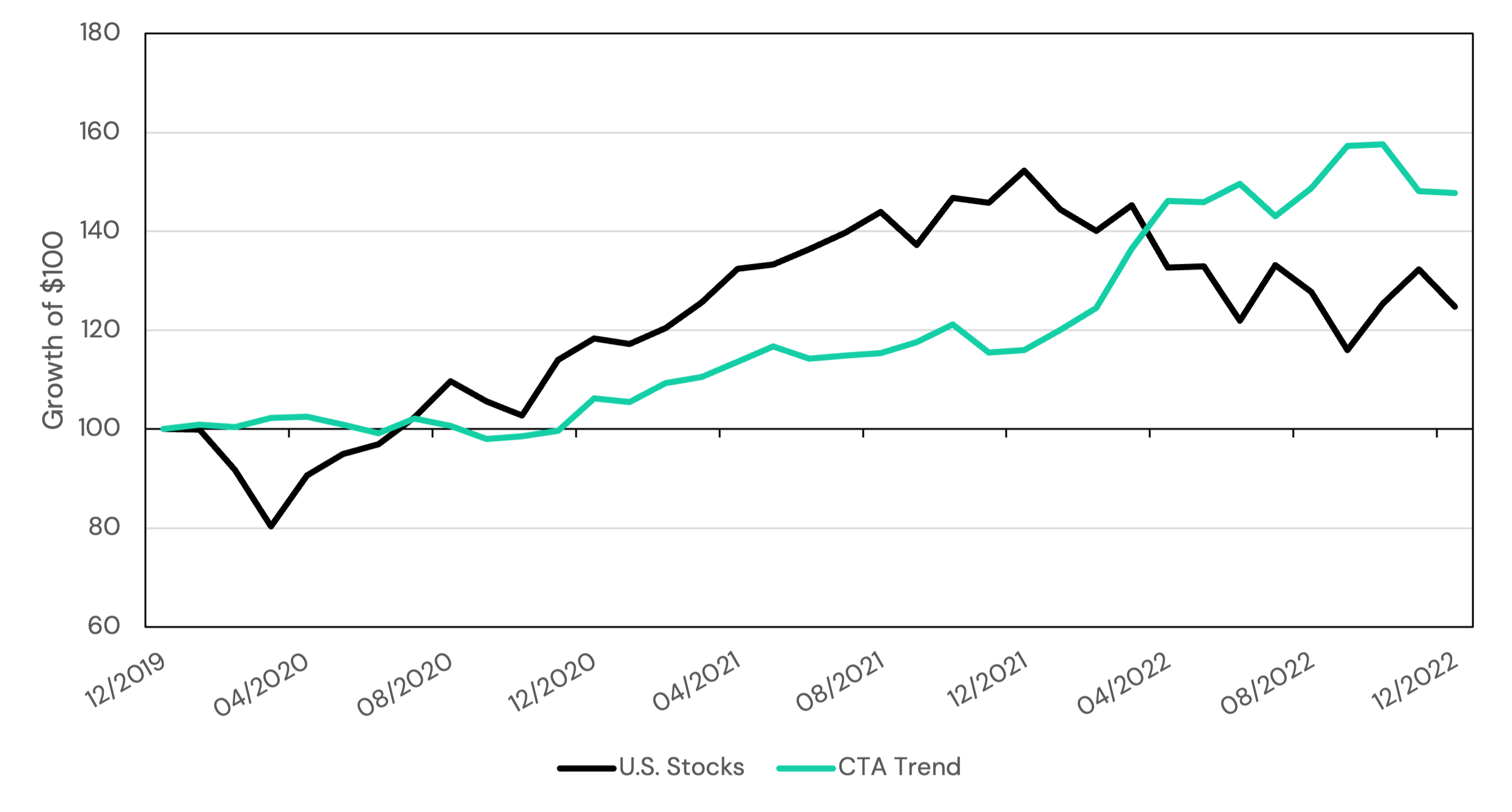Behavioral Alpha: How Return Stacking Can Help Investors Avoid Line-Item Risk
Overview
Investors often struggle to hold onto diversifiers like managed futures when they underperform traditional stocks, leading to costly market timing mistakes. This behavioral bias – known as line-item risk – causes investors to abandon hedging strategies precisely when they are most needed. Return stacking offers a structural solution by embedding diversifiers into a single portfolio allocation, reducing the emotional impulse to sell underperforming assets at the wrong time. This article explores how return stacking can improve investor discipline, enhance portfolio resilience, and help financial advisors build more behaviorally friendly investment strategies.
Key Topics
Why Investors Struggle to Hold Diversifiers
A prime example of this bias is seen in alternative investments like managed futures, which have historically performed well during equity downturns but can experience extended stretches of underperformance in strong bull markets. When managed futures struggle while stocks rally, investors often feel compelled to sell them—even though they are precisely the asset class that helps offset future drawdowns.
The Return Stacking Solution
Instead of deciding whether to hold onto managed futures during a bull market, investors in a return stacked® portfolio remain exposed to both equities and trend-following strategies at all times, leading to more disciplined investing and improved long-term outcomes.
Historical Data: The Impact of Line-Item Bias
A 2022 Morningstar study on investor returns found that investors in managed futures funds underperformed the actual fund performance by over 3% annually due to poor market timing decisions. This “behavior gap” highlights the difficulty investors have in holding onto diversifiers when they are not performing well in isolation.
By contrast, return stacked® portfolios inherently smooth the investment experience, leading to more consistent exposure to diversifying assets over time.
Comparing Standalone vs. Return Stacked® Portfolios
| Period | Standalone Managed Futures |
Return Stacked® Portfolio |
| 12/2014-12/2019 | -0.8% annualized | +9.6% annualized |
| 12/2019-12/2022 | +13.9% annualized | +22.4% annualized |
Source: Bloomberg. Calculations by Newfound Research. Past performance is not indicative of future results. Standalone Managed Futures is the SG Trend Index (NEIXCTAT). The Return Stacked® Portfolio is 100% S&P 500 Total Return Index (”SPXT”) / 100% NEIXCTAT / -100% Bloomberg Short-Term US Treasury Bill Index (”LD12TRUU”) rebalanced monthly. Performance is gross of all fees, taxes, and transaction costs. Performance assumes the reinvestment of all distributions. Performance of NEIXCTAT is net of underlying management and performance fees. Data is for illustrative purposes only.
Register for our Advisor Center
Tools Center:
Easily backtest & explore different return stacking concepts
Model Portfolios:
Return stacked allocations, commentary and guidance designed
for a range of client risk profiles and goals
Future Thinking:
Receive up-to-date insights into the world of return stacking theory and practice
The Potential Psychological Advantage of Return Stacking
- Reduces Visibility of Individual Losses: When managed futures are integrated into a return stacked® portfolio, investors see a blended return rather than isolating short-term underperformance.
- Encourages Long-Term Thinking: Investors who see steady participation in equities and managed futures are less likely to make reactionary decisions.
- Smooths Volatility and Drawdowns: Historical data suggests that managed futures have provided positive returns during equity crises, leading to better overall risk-adjusted performance.
How Advisors Can Use Return Stacking to Reduce Behavioral Drag
Financial advisors often struggle to keep clients invested in diversifying assets, especially when they underperform equities for extended periods. Traditional approaches to diversification require advisors to persuade clients to maintain separate allocations to alternatives – a difficult task when those allocations are underperforming stocks.
By embedding managed futures into a single, return stacked® investment, advisors can reduce friction and improve long-term adherence to a well-diversified portfolio strategy.
Case Study: The Cost of Abandoning Diversifiers
By mid-2022, equity markets had declined significantly, and managed futures had delivered strong returns. Had the investor maintained their original allocation, their portfolio volatility would have been lower, and their overall return higher.
The Advisor’s Role in Implementing Return Stacking
- Educate Clients on the Concept of Blended Returns: Help clients understand that return stacking allows them to keep full equity exposure while benefiting from diversifiers.
- Use Historical Data to Illustrate Behavioral Pitfalls: Show how investors tend to sell alternatives at the wrong time and how return stacking can mitigate this behavior.
Key Takeaways for Advisors
- Line-item bias leads to premature selling of diversifiers, often at the worst possible time.
- Return stacking integrates managed futures into an all-in-one portfolio, reducing the likelihood of emotional decision-making.
- Investors who remain consistently exposed to diversifying assets through return stacking tend to experience smoother long-term outcomes.
- Advisors can use return stacking as a behavioral tool, helping clients stay invested in a well-diversified strategy.
Final Thoughts
Behavioral biases like line-item risk make it difficult for investors to maintain exposure to diversifiers like managed futures. Return stacking offers a powerful solution by embedding these diversifiers within a single allocation, reducing emotional decision-making and increasing the likelihood of long-term investment success.
For advisors, this approach represents an elegant way to help clients stay invested in both equities and alternative strategies – a key factor in achieving robust long-term outcomes. As return stacking becomes more widely adopted, it has the potential to transform how advisors construct and manage client portfolios for sustained success.

